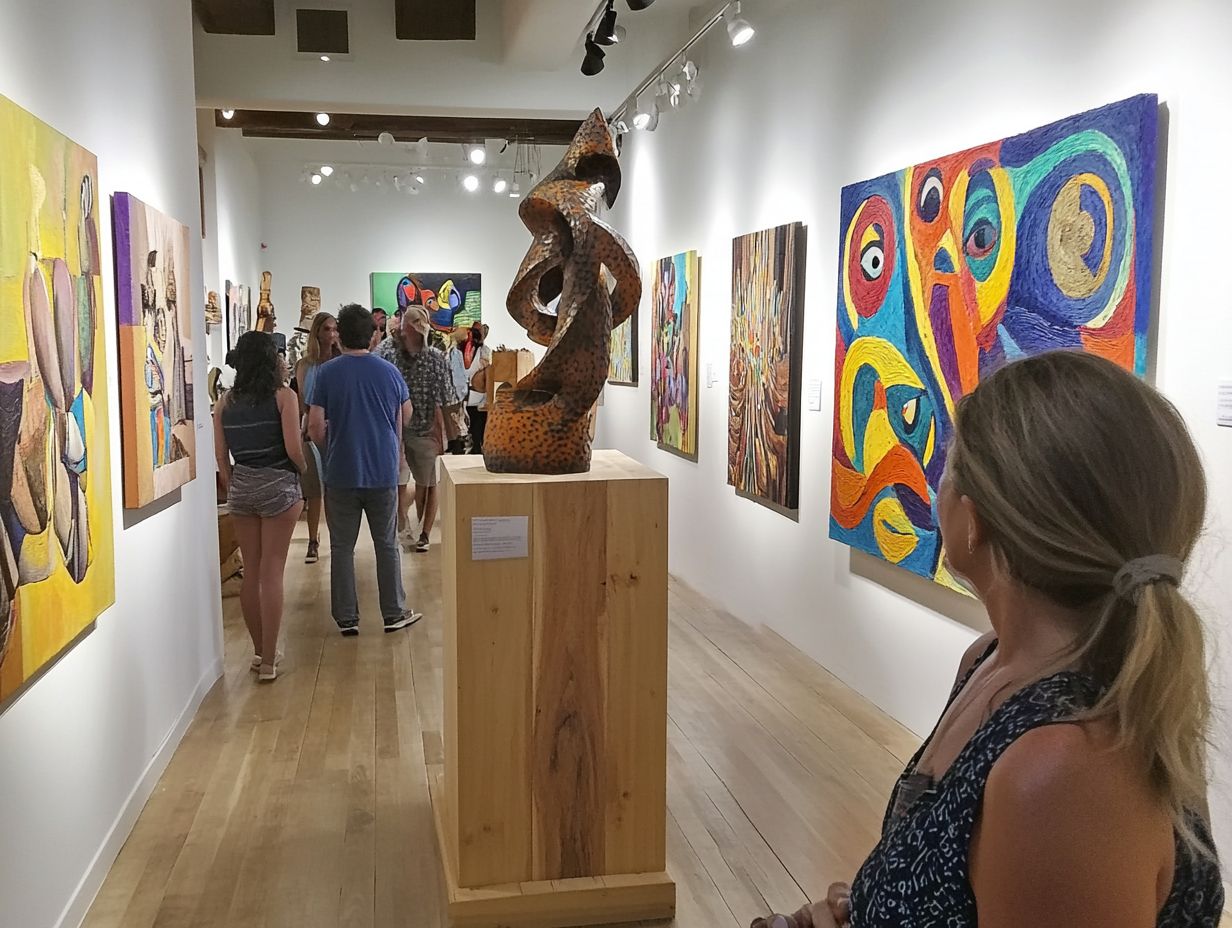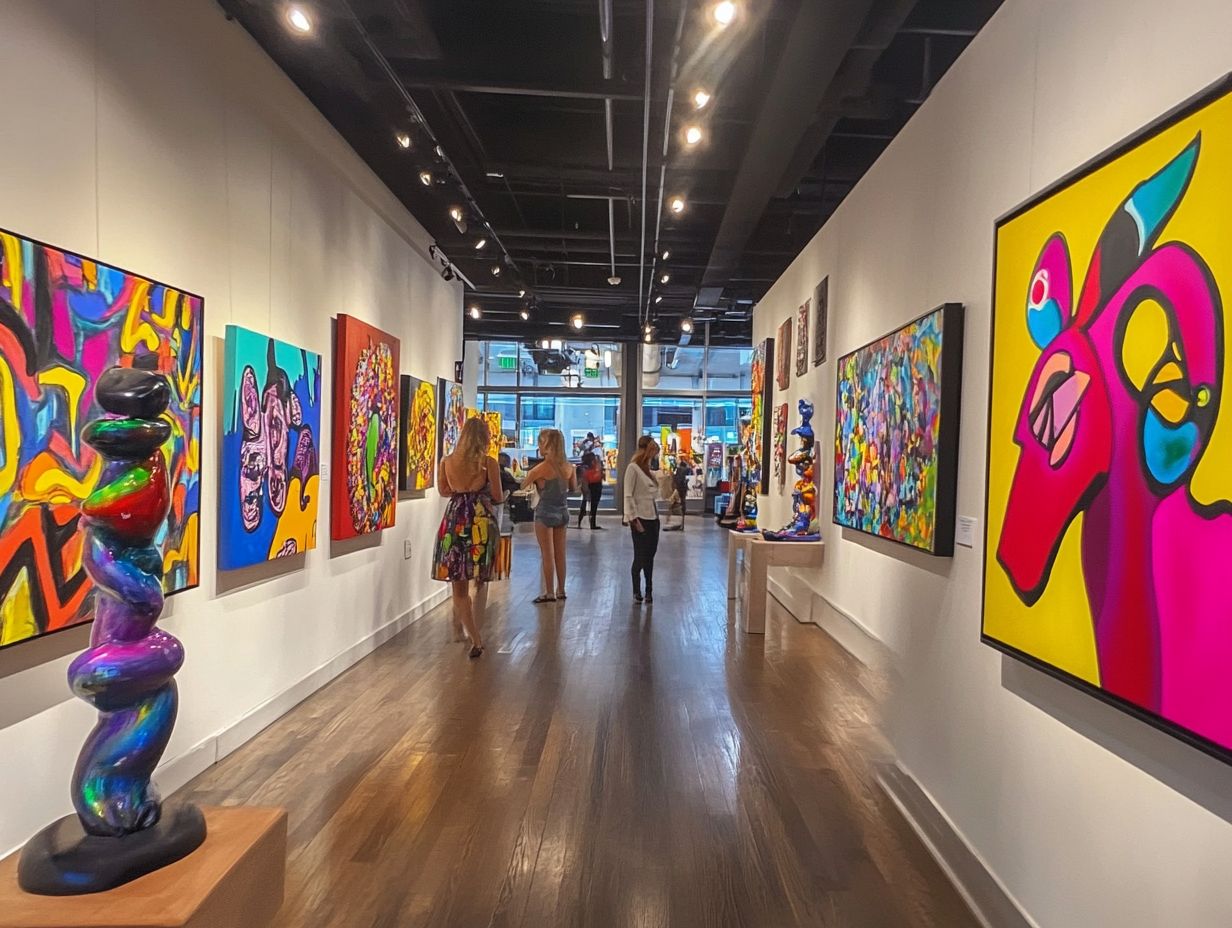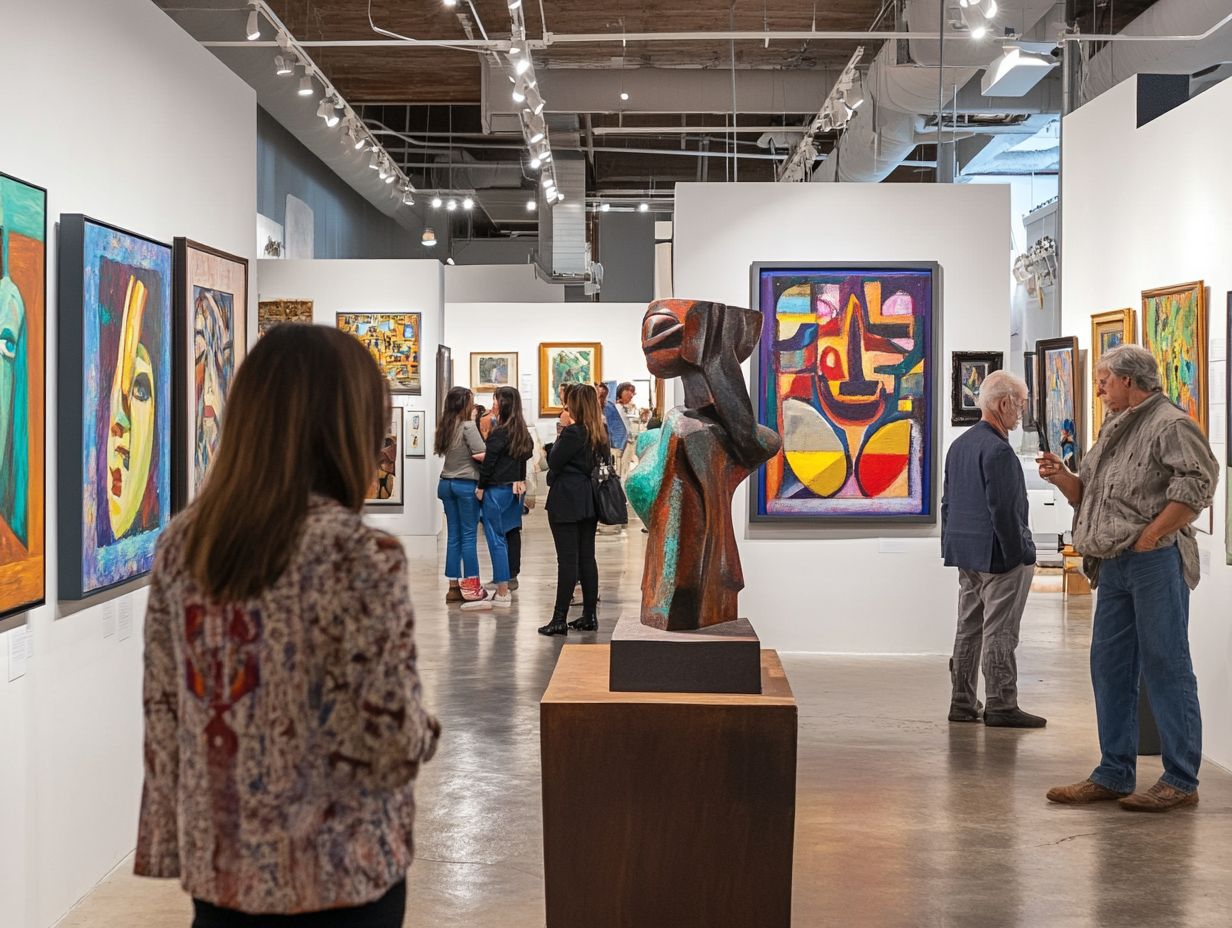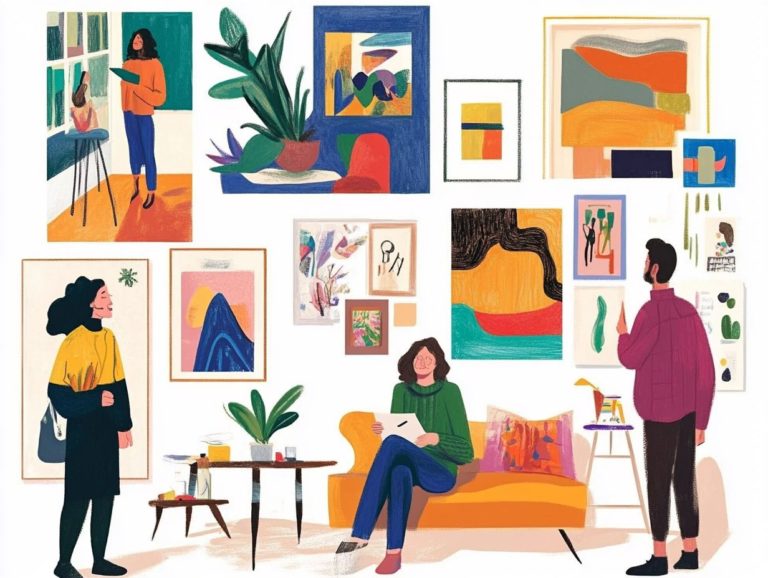What Makes Art Collectible? Key Factors Explained
Art collecting is a journey that intricately weaves together passion, investment, and a deep appreciation for creativity.
This article delves into the essence of art collecting, beginning with what defines it and the key factors that elevate art to true collectibility. Consider rarity, authenticity, the reputation of artists, and cultural significance; each of these elements holds immense importance in your collecting journey.
You ll explore investment strategies, potential returns, and essential care techniques for your collection, ensuring it endures through time. Dive into the world of art collecting as the intricacies of this enriching pursuit are unraveled, revealing the depth and beauty that art collecting has to offer.
Contents
Key Takeaways:

- Rarity and authenticity are crucial.
- A curated collection can yield returns but may involve risks.
- Preservation techniques are vital for maintaining value.
Understanding Art Collecting
Understanding art collecting goes beyond just buying art; it invites you into a world rich with intrinsic and emotional value. For you, the journey involves grappling with the historical significance of each work, considering the reputation of the artists, and exploring the unique styles that define various movements throughout art history.
Understanding market value is also important for making informed, discerning decisions in this captivating realm.
What is Art Collecting?
Art collecting is more than just acquiring pieces; it s a passionate journey through the realms of art history and distinctive styles. This pursuit allows you to express your personal values and aesthetic preferences, curating a collection that resonates with your experiences or holds historical significance.
Your motivations for collecting can vary widely, from the desire to invest in tangible assets that appreciate over time to the deep emotional satisfaction of owning a piece that carries intrinsic meaning. Explore different art forms like:
- paintings
- sculptures
- photographs
- textiles
Each piece contributes to the unique narrative you re building. Engaging with the vibrant community of art enthusiasts enhances the experience, as you connect through galleries, auctions, and festivals. Don t miss out on the chance to connect with this vibrant art community!
Factors that Make Art Collectible

Several key factors come into play when considering what makes art truly collectible. Rarity and authenticity are paramount, but you also have to factor in the artist’s reputation and the interest collectors have in specific types of art.
Each of these elements plays a crucial role in shaping the overall worth of a piece, influencing not just its value but also its appeal to collectors like yourself.
Rarity and Authenticity
Rarity and authenticity are essential elements that significantly influence the value of artworks in the art market. Unique pieces or limited editions often capture the attention of collectors, commanding higher interest and prices.
When contemplating financial investments, these factors become critical during the auction process. The scarcity of a work can ignite bidding wars, pushing prices to astonishing heights. Authenticity adds yet another layer of importance; buyers actively seek verifiable provenance, which is the history of ownership of a piece, to ensure they’re acquiring genuine artworks.
The dynamic between rarity and authenticity ultimately shapes not only the perceived worth but also the potential for future appreciation in value. This knowledge gives you the power to make informed decisions as you navigate the competitive landscape of art acquisition.
Artist Reputation and Market Demand
The reputation of an artist significantly influences market demand. Established artists like Vincent van Gogh, Pablo Picasso, and Yayoi Kusama command premium prices for their works, driven by the feelings collectors associate with them.
This correlation between an artist’s standing and the appeal of their creations spans various eras. Art critics elevate lesser-known artists into the spotlight, enhancing the desirability of their pieces.
Take Frida Kahlo, for instance. Her distinct style and compelling personal narrative have turned her work into sought-after treasures that resonate deeply with audiences today.
Contemporary artists like Banksy exemplify this relationship as well. Their fame incites a frenzy of interest, leaving collectors racing to secure a piece before prices soar.
Emotional value drives market demand! The stories conveyed through art not only enrich cultural narratives but also shape the financial landscapes surrounding artistic endeavors.
Subject Matter and Cultural Significance

The subject matter of a work of art, along with its cultural significance, plays a vital role in shaping its appeal and perceived value in society. It often reflects social status or shared beliefs.
This dynamic interplay reveals how themes like love, conflict, spirituality, and identity resonate through diverse cultural perspectives.
Different communities interpret the same artistic expression in unique ways, assigning distinct emotional values shaped by their histories, traditions, and social contexts.
For example, an artwork portraying themes of struggle could evoke a sense of solidarity in one culture while sparking a conversation about resilience in another.
These varied interpretations highlight that art is not merely about aesthetics; it s profoundly impactful, serving as a bridge that connects individuals to their heritage and each other.
Condition and Provenance
The condition of a work and its provenance, or documented history of ownership, are crucial elements in the art market. They play a significant role in determining both price and historical importance.
When evaluating a piece for auction, collectors and bidders scrutinize its physical state closely. Any signs of restoration, deterioration, or damage can dramatically influence desirability and market value.
A well-documented lineage from artist to owner transforms a work into more than just an aesthetic object; it becomes a tangible piece of art history.
Auction houses know these attributes heighten demand and drive prices upward, reflecting an increasing appreciation for both the artwork’s physical and historical context.
Investing in Art Collectibles
Investing in art collectibles offers a distinctive avenue for financial growth. However, it carries potential rewards and inherent risks that every astute art collector must consider.
Tips for Building a Collection

Building an art collection demands strategic planning and a keen understanding of your personal taste and the unique styles that resonate with you.
Start by exploring various genres and mediums to uncover what captivates your interest. Engaging with local galleries and art fairs provides invaluable insights into market demand, helping you gauge which artists are gaining traction.
Each piece should evoke a personal connection rather than just serve as an investment. With the right approach, you can identify artworks that hold potential value while enriching your living space.
Ultimately, your collection should reflect both your passion and strategic foresight, creating a harmonious balance between heart and market trends for lasting satisfaction.
Potential Returns and Risks
Art collectibles can offer substantial returns. However, understanding the risks is essential for anyone looking to invest in the art market.
The chance to own a unique piece that appreciates in value is tempting. Yet, price fluctuations make the art market unpredictable.
You must navigate various market dynamics, such as changing tastes and economic conditions. These factors can significantly affect valuations.
The art market often lacks liquidity, which can create hurdles when selling. This situation can lead to losses if the timing is not right.
By carefully evaluating these factors, you ll be able to manage the balance between reward and risk in art investing.
Caring for Art Collectibles
Caring for your art collectibles involves using specialized preservation techniques and maintenance practices designed to keep your pieces in optimal condition over time.
By adopting these methods, you can safeguard the integrity and beauty of your collection and ensure that each artwork continues to captivate for years to come.
Preservation and Maintenance Techniques
Effective preservation techniques are vital for maintaining the quality of your art pieces. This requires careful attention to their condition and the surrounding environment.
To ensure longevity, various methods tailored to specific mediums are necessary.
For example, acrylic paintings thrive in a stable, low-humidity environment, which helps prevent warping and fading.
On the other hand, oil paintings require regular dusting and careful monitoring of light exposure to avoid color degradation.
Paper artworks need archival-quality framing materials to protect against acidic deterioration. Sculptures, which often face fluctuating conditions, must be cleaned and conserved with appropriate materials that won t react adversely.
By following these practices, you can significantly extend the lifespan and aesthetic integrity of your cherished works.
Frequently Asked Questions
What makes art collectible?
Art becomes collectible when it is highly sought after and valued by collectors. This can be influenced by various factors such as the artist’s reputation, uniqueness, and historical significance.
What are key factors that make art collectible?
The key factors that make art collectible include the artist’s credibility, rarity, provenance (the history of ownership), medium, and cultural significance. These elements contribute to the value and desirability of a piece of art.
How does an artist’s reputation affect the collectibility of their art?
An artist’s reputation plays a crucial role in the collectibility of their art. A well-established and respected artist in the art world will attract more attention and demand, making their pieces more valuable and collectible.
Why is rarity an important factor in determining the collectibility of art?
Rarity adds to the exclusivity of a piece of art, making it more desirable for collectors. The more limited the number of pieces created by an artist, the more valuable and collectible they become.
What is the significance of provenance in collectible art?
Provenance refers to the documented history of a piece of art, including its ownership, exhibition history, and authenticity. It plays a crucial role in determining the collectibility and value of a piece of art.
How does cultural significance impact the collectibility of art?
Cultural significance refers to the impact and influence a piece of art has on a particular society or culture. Art that holds cultural significance is highly sought after by collectors, thus making it more collectible.





